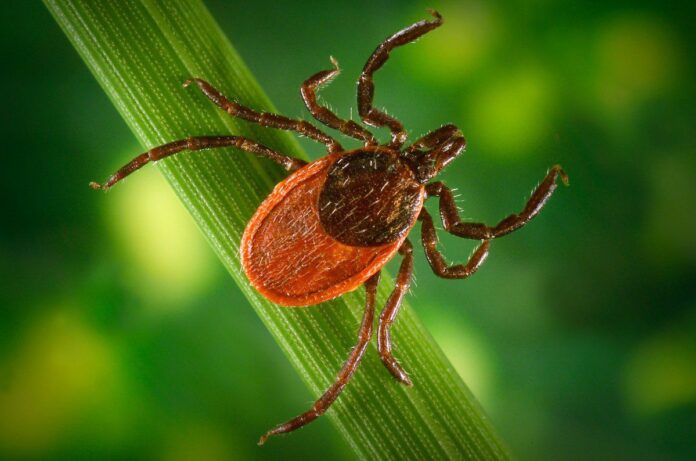My daughter returned from her latest campout on Sunday with a tiny traveler that decided to hitch a ride on her shoulder. She discovered and removed the tick in the shower, smashed it and promptly explained to me what it looked like. It was an American dog tick.
After about 30 minutes of combing through her hair and checking her ears, we confirmed it was the only hitchhiker she brought back with her. But the whole experience was a good reminder that it’s tick season and they are prevalent in Ohio throughout the spring, summer and fall.
Ticks can pose a threat to humans because they are vectors for disease. When you spend time outdoors, you should always check yourself for ticks. Removing them sooner can help prevent the transmission of Rocky Mountain spotted fever, tularemia, Lyme disease, anaplasmosis, babesiosis, Powassan virus disease, ehrlichiosis and other illnesses.
Prevent tickborne diseases
The first step to prevent tickborne diseases is protecting yourself against tick bites. Follow these tips from the Ohio Department of Health:
- Wear long pants, long sleeves and long socks when you’re outdoors in wooded and brushy areas with high grass and leaf litter.
- Tuck your pant legs into your socks or boots and tuck your shirts into your pants to keep ticks from getting inside your clothing.
- Wear light-colored clothing so you can spot ticks that have hitched a ride more easily.
- Ticks have a unique strategy called questing to allow it to find new hosts. They will climb up a blade of grass or other structure, extend their front legs and wait to come into contact with a suitable host. Walking in the center of trails and limiting contact with tall grass will help you avoid picking ticks up.
- You can apply insect repellents labeled for use against ticks registered by the U.S. Environmental Protection Agency to you skin to protect yourself for several hours. Follow label instructions.
- You might also treat clothing, tents, backpacks and other hiking equipment with products containing 0.5% permethrin to keep it protected for several washes or purchase pre-treated clothing.
The next step to prevent tickborne diseases is checking for ticks.
Before you head inside:
- Check your clothing thoroughly and remove and eliminate ticks. Many ticks have a hard exterior shell, which makes them difficult to kill. However, it can be done by spliting them with something sharp, lighting them on fire, putting them in alcohol, placing them in a sealed bag/container, wrapping them tightly in tape, flushing them down the toilet or freezing them. Placing a tick in a sealed container is the best option if you plan to have the tick identified by your local health department. Never crush a tick with your fingers.
- Thoroughly check your gear and pets to make sure they aren’t transporting any ticks. Ticks that make it indoors could attach to a person later.
After you’re inside:
- Toss dry clothes in a dryer on high for 10 minutes to kill ticks that might still be on them after you come indoors. If clothes are damp, additional dry time is needed. If they need to be washed first, use hot water.
- Shower as soon as possible — within 2 hours of coming indoors — to find and wash off any ticks that may be crawling on you.
- Check your entire body for ticks using a full-length or hand-held mirror after you shower to make sure you didn’t miss any. PAy extra close attention to these areas: underarms, in and around ears, belly button, behind knees, between legs, around wrists and in hair.
If you find any ticks, remove them as soon as possible.
- Use fine-tipped tweezers to grab the tick as close to the surface of the skin as possible.
- Pluck it from skin with steady, even pressure. Don’t twist or jerk the tick because it could cause mouthparts to break off in the skin.
- If mouthparts break off in the skin, remove them with tweezers. If you are unable to remove them easily, leave them alone and allow skin to heal.
- Dispose of the tick.
- Wash your hands and the site of the bite with soap and water.
- Never use home remedies, such as petroleum jelly, a hot match or nail polish, to remove a tick. They don’t work.
If you removed a tick, be sure to watch for signs and symptoms of illness in the days and weeks that follow. Many tickborne diseases have similar symptoms. These include:
- Fever and chills.
- Aches and pains. Symptoms of tickborne diseases include headache, fatigue and muscle aches. Joint pain is an additional symptom of Lyme disease. The severity and onset of symptoms varies depending on the tickborne disease and the tolerance level of the patient.
- Rash. A distinctive rash can result from Lyme disease, southern tick-associated rash illness (STARI), Rocky Mountain spotted fever (RMSF), ehrlichiosis and tularemia.
If you start feeling ill or notice any of the symptoms above, it’s best to see a doctor. Early diagnosis is key in treating tickborne diseases as they are easily treated with antibiotics but difficult to diagnose. Earlier treatment decreases the risk of serious complications from tickborne illnesses.
Related Content
- How to identify disease-carrying ticks in Ohio
- How to survive tick attacks
- Protect yourself from tickborne diseases












